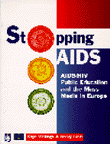

![]()
![]()

Each chapter in the first half of the book is written around a specific theme, eg. 'solidarity campaigns'; 'motivating behavioural change'; and 'setting the agenda', whilst the second half consists of country reports. There are 47 coloured HIV health promotion adverts and many more black-and-white ones. These are well commented and reflected upon and do not act merely as attractive space fillers. The often quoted and much criticised UK campaign 'Don't die of ignorance', remembered by many as 'the iceberg advert', is mentioned several times. However, Wellings and Field (p. 54) remind us that the use of 'fear' in AIDS health education was not unique in Europe; other early campaigns, for example in the Netherlands 'were also characterized by some reliance on the use of fear'. The book gives an interesting rationale for and against the use of fear and humour, the two most commonly used emotions in AIDS mass media messages (pp. 56 - 63).
Many of the issues addressed in this book are not particular to AIDS mass media campaigns, such as the question whether to target specific/high-risk groups or the population as a whole. The population approach targets all, which would be particularly useful when using a high-risk approach means that the general population would not identify with the message, and thinks 'It can't happen to me, since I'm not a prostitute, nor gay, nor inject drugs'. Moreover, using a population approach also avoids putting stigma of being HIV on already stigmatised groups.
However, chapter 8 addresses 'Specific issues in AIDS public education', such as the taboo on showing an erect penis in adverts; the allegation that health education encourages undesirable/immoral behaviour and condones casual sex. The main advantage of the (potential) objections from some influential sectors in society to the different campaigns has undoubtedly led to the high proportion of interventions being evaluated. Many of these evaluations are referred to in this book.
The second half of the book covers reports from 18 western European countries. Each report provides some background information on epidemiology, national politics and law, and highlights specific national campaigns. Having comparative information available on different countries is good source for those who do not speak Europe's minority languages. In order to make an assessment of the quality, reliability and timeliness of the details I considered the reports for the Netherlands and the UK. Dutch policy documents have been well translated by a native Dutch speaker, Greet Peersman, a health promotion researcher based in at the Institute of Education (London). Reading the country sections made me aware that the authors have taken a fairly limited definition of public education and mass media. It really refers to national health promotion campaigns to the general public by official national organisation. For example, for Britain the focus is predominantly the Health Education Authority's mass media work, and although the Health Education Board for Scotland is briefly mentioned (p. 250), its mass media campaigns are not covered.
A minor blemish is that sometimes the reader is left wondering if a subjective statement reflects the authors' opinion, or whether research has indicated that a particular campaign in a particular country was good, successful or not understood, or whether policy-makers had concluded this in their national papers which in turn were quoted. For example on page 36, 'This part of the campaign attracted a good deal of attention', it is unclear who says so? Is it the authors, the Swiss Government, its national health promotion organisation, or is there evidence from independent research?
This book is a very useful addition for those studying health promotion, public health, media studies and medical sociology. Overall the comparative element is its major strength.
Edwin van Teijlingen
University of Aberdeen